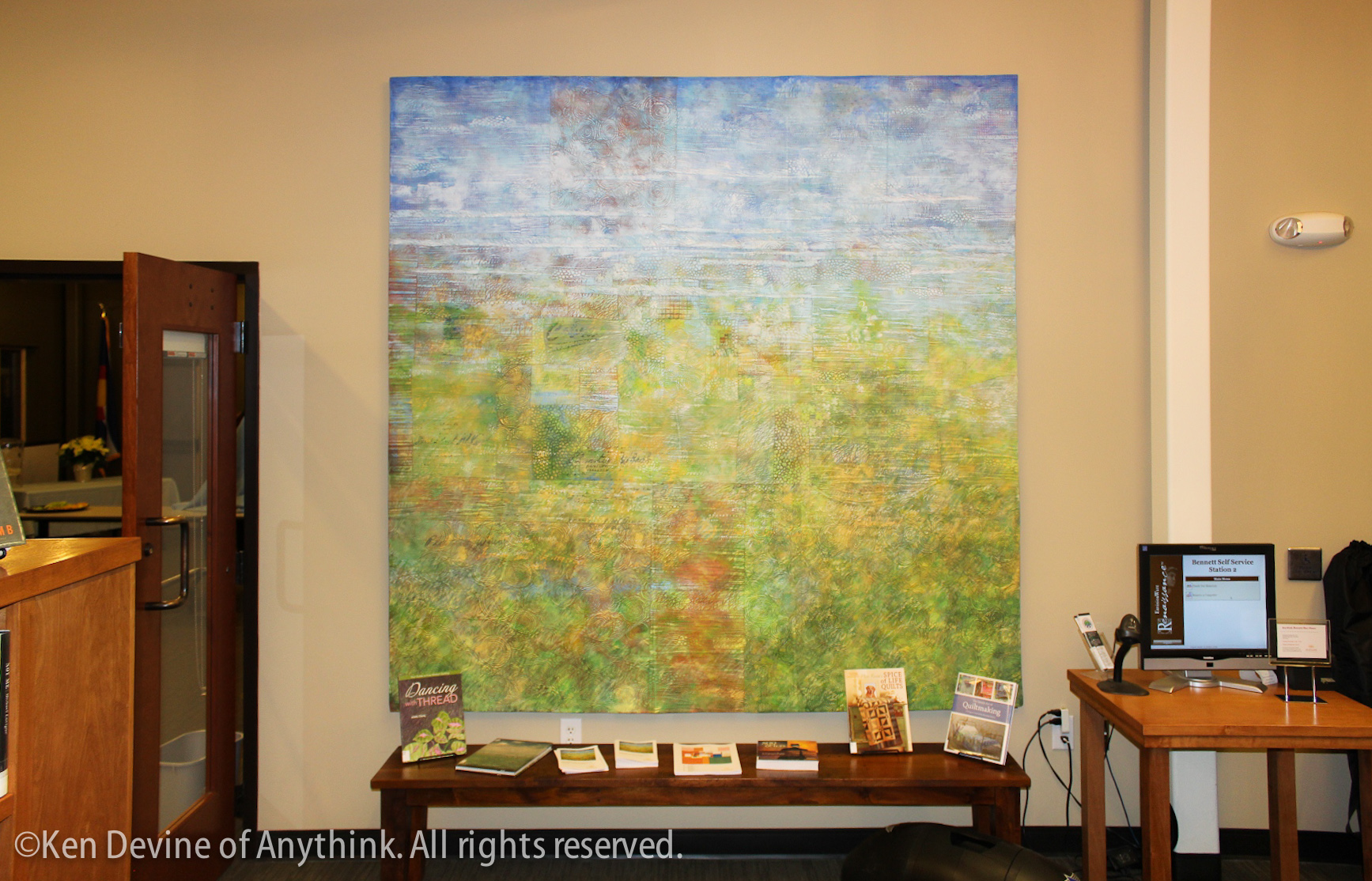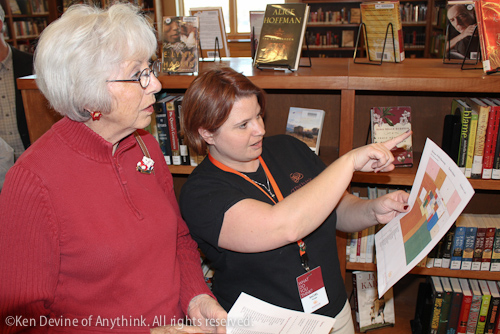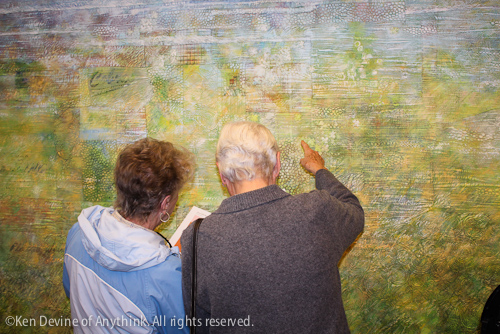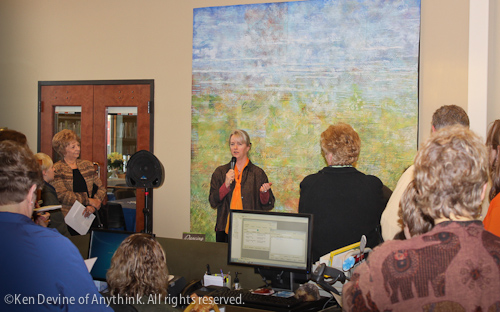 Horizon XVIII: Plainsong
Horizon XVIII: Plainsong
90 x 90 inches, acrylic paint on stitched textile – installed at AnyThink Library, Bennett, Colorado
Hanging a textile piece can be done any number of ways. Some people like to frame them, but I’ve decided that that particular aesthetic doesn’t appeal to me. I believe a textile should be free to assert its own identity, and it shouldn’t be forced to pretend it’s a painting just because that’s what people are used to. The wrong kind of frame (too ornate, or calling too much attention to itself) can also, in my opinion, reduce a textile piece to functioning as mere decoration, looking like something you might find mass produced for display in a model home. Of alternative hanging methods, probably the most common involves stitching a sleeve to the back to accommodate a wooden or metal slat which can then be nailed to the wall. This allows the piece to hang free, and it’s what I usually do for my larger pieces.
However, this particular piece needed something more substantial. For another commission I did a couple of years ago, I had custom canvases built to size and stitched the pieces to them. This worked great for 36×36-inch pieces, but due to the sheer size of the current one, the ultimate problem of transportation ruled out that idea. So I enlisted the help of my very resourceful husband, and here’s what we came up with.
 This frame is built of light-weight but sturdy 1×2 (actual measurements .75 x 1.5 inches) hardwood. It was preprimed, so painting it black was very easy. The frame was built in two sections that bolt together, which meant we could fit it into our old Ford Explorer for transport. Library facilities men attached it to the wall.
This frame is built of light-weight but sturdy 1×2 (actual measurements .75 x 1.5 inches) hardwood. It was preprimed, so painting it black was very easy. The frame was built in two sections that bolt together, which meant we could fit it into our old Ford Explorer for transport. Library facilities men attached it to the wall.
 To attach the quilt to the frame, I used hook & loop tape from Uline. It comes with or without a sticky back. I bought sticky hook side, which I stuck to the entire perimeter of the frame, and some strategic spots on the inner supports. I didn’t think the stickiness alone would be enough, so I reinforced it with staples about every 5-6 inches. I bought the non-sticky loop side to attach to the quilt by hand stitching. I had said in a previous post that I’d found one aspect of making art that I really don’t like – this is it. Nope – no fun at all. When I am rich and famous, I shall hire someone to do this for me.
To attach the quilt to the frame, I used hook & loop tape from Uline. It comes with or without a sticky back. I bought sticky hook side, which I stuck to the entire perimeter of the frame, and some strategic spots on the inner supports. I didn’t think the stickiness alone would be enough, so I reinforced it with staples about every 5-6 inches. I bought the non-sticky loop side to attach to the quilt by hand stitching. I had said in a previous post that I’d found one aspect of making art that I really don’t like – this is it. Nope – no fun at all. When I am rich and famous, I shall hire someone to do this for me.
Because the hook & loop tape works quite well to attach the quilt to the frame, it also tries to stick itself anywhere it gets a chance, even if that’s in a spot you hadn’t intended. So it took all four of us to do the final hanging – two getting it into position, and two holding out the bottom so it couldn’t stick in the wrong spots prematurely.
 Lots of adjusting was then required to be sure it was in the exact right position to the frame.
Lots of adjusting was then required to be sure it was in the exact right position to the frame.
 Later that afternoon, the library held a small reception for all the people who had participated in the project.
Later that afternoon, the library held a small reception for all the people who had participated in the project.
 Since the painting over the fabric made it difficult to see, I had also made a map showing where in the piece each person’s fabric was used.
Since the painting over the fabric made it difficult to see, I had also made a map showing where in the piece each person’s fabric was used.
 People seemed to be having a great time picking out their fabrics and telling one another about the meaning each piece had for them.
People seemed to be having a great time picking out their fabrics and telling one another about the meaning each piece had for them.
 I had to say some “official words.”
I had to say some “official words.”
Then there was an afternoon tea with delightful refreshments, and a chance to talk to some of my new friends once again. The high point of the day was when a young girl asked me for my autograph and had her friend take a picture of us together. I felt like a rock star!

Deidre – THANK YOU for this informative series of blog posts on the evolution of your commission. I have really enjoyed reading about how you addressed the creative and engineering challenges of this textile work.
And, I agree, attaching velcro is the pits!
Brenda, ha ha, you just cut right to the chase there! Thanks so much for taking the time to read all my ramblings.
Darn – I was hoping for another video of your “official words”.
The artwork looks fabulous in the library. Well done.
I have thoroughly enjoyed this step-by-step you shared on making this piece. Thanks for sharing. I’ve admired your work since I became aware of it, a few years ago now. You are a rock star!!!
Lisa, ha! I’m pretty sure what I said was completely incoherent. If anyone took a video of that, it would be good blackmail material. Terri, thanks so much for the kind words.
Wow – thnaks for the photos and for the notes! For me especially interesting to see the photo of the prairie; I guess those of “back East” think of Colorado and the mountains. Wonderful to see the evolution and the finished quilt/painting – wow! Look forward to seeing it “in person” this spring.
Magnifique travail, j’aime beaucoup félicitations
Beautiful work, I love Congratulations
Enjoyed both the process and the product! Machine stitching the fuzzy velcro to finished canvas sleeves, then hand stitching the sleeves to the quilt is another method to hang large pieces from a velcroed frame–ask me how I know.
Thanks for sharing,
Linda Laird
SAQA SoCal/SoNev
Susan – yes of course, there are the mountains that most people think of first, but Colorado has a surprising diversity of landscape features, and just for looking at, I think I like the plains just as well if not better than the mountains. Strange, eh?
Marianne, merci beaucoup!
Linda – I did consider that method, but I was worried there might be a little extra “give” to the fabric that way, and I just did not want to take any chance whatsoever with this piece. I wanted to make sure it was tacked on very tightly and would not pull forward from the frame at all. I’m going to test it on a smaller piece in the future, though.
Deidre, wonderful piece and such a great documentation of the process. And what a great way to market your commission work in the future.
Having older fingers that rebel at stitching the Velcro directly onto the quilt, I machine sew the Velcro to twill tape that is a bit wider than the Velcro, then hand stitch the tape to the quilt. Much easier on the fingers.
Thanks so much for sharing.
Deidre, thanks for sharing your process on this beautiful artwork. It’s gorgeous. I just began reading your blog after I saw your bit on Quilting Arts DVD. I wish Quilting Arts had given you more time because I wanted to know more about your work.
Deidre,
You have given us a marvelous gift by describing so fully your process at arriving at this amazing piece! Thank you so much for sharing so many new possibilities for creating fabric art. It was like magic when I saw how you incorporated the diverse pieces (plaid shirt!) into a cohesive whole.
I so enjoyed reading through the whole account! Thank you!
Deidre,
I have been fascinated by this series of posts. Thankyou very much! Also really appreciated seeing the hanging process! Congratulations on a wonderful quilt!
This has been wonderful to follow right through to the final presentation. Congratulations on this beautiful commission and thank you for sharing!
Dierdre,
Loved watching your process and found it unbelievable how quickly you put this piece together. Thank you for sharing. Pat Bishop – Fiber Rich – Soul Nutritious
Deidre, Thank you once again fcr sharing this process. Being a former social worker, questions and thoughts lurk in me on how I can intensely merge art-making and community activism, or at least art-making to create a larger sense of community. The way you went about this commission seems to me a strong balance between community and the need to create alone.
Thanks, Karen. I’ve been thinking about that a lot lately too. I would like to start using artwork as a way to do some good in the world. I’m just not sure how to go about that. Since as you say, the need to create alone is important, is there a way to involve other people to become a part of something bigger than myself without allowing the larger mission to be derailed by some of the inevitable issues that working in groups involves?
you are a rock star! thank you for sharing your process!
I have loved following the evolution of this quilt and am in awe of your vision — being able to see how the disparate bits and bobs would be unified by your painting and your intent. Thanks so much for all the work it took to post all these details to share with those of us who enjoy reading your blog. Here’s wishing you another great artistic year.
Jeannette
Deidre,
I finally had time (snowed in) to read all the blogs and now understand how it was done. Will never complain again when I machine quilt a piece after seeing this. Great explanations!
Peg
Thanks for sharing this. I had no idea how your pieces evolved, having only seen the finished work. Stunning!